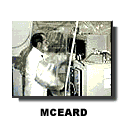Microbiological
and Chemical Exposure Assessment Research Division

Welcome to the Microbiological and Chemical Exposure Assessment Research Division (MCEARD) Home Page. It is a division of the National Exposure Research Laboratory (NERL) and operates within the Office of Research and Development (ORD).
MCEARD conducts research to measure, characterize and predict the exposure of humans to chemical and microbial hazards. This research provides information on environmental pathways which contaminants of public health concern are transported to populations at risk. Analytical quantitative methods are developed to accurately and specifically measure human risk factors associated with inhalation, ingestion and dermal pathways. Surveys and monitoring studies are carried out to determine the levels of hazardous chemicals and microbials in environmental matrices, and human populations are studied to determine significant exposure pathways, the levels of exposure, and the sources of exposure factors. State-of-the-art analytical methods are used to measure organic and inorganic chemicals. Genomic and immuno-based methods, as well traditional cultural methods, are used to measure hazardous bacteria, viruses, fungi, and protozoa. Molecular- and sero-epidemiological tools are used to assess human populations for evidence of exposure to environmental hazards. The Division conducts its multidiscipline research program with a broad skill mix of scientists that includes organic, inorganic, and analytical chemists, bacteriologists, virologists, parasitologists, immunologists, and molecular biologists. The Division is one of several U.S. EPA research organizations located in the Andrew W. Breidenbach Environmental Research Center at 26 West M.L. King Drive, Cincinnati, Ohio, 45268 . This Center is in the Clifton/Corryville area just north of downtown Cincinnati and is located between interstates I-75 and I-71. It is situated adjacent to the main campus of the University of Cincinnati. The Division consists of three branches, the Biohazard Assessment Research Branch, the Microbial Exposure Research Branch, and the Chemical Exposure Research Branch.
MCEARD Online Methods: These methods
were developed with MCEARD support. They are in Adobe Acrobat
® PDF format.You will need Adobe Acrobat Reader to view PDF
files. See EPA's
PDF page for more information about getting and using
the free Acrobat Reader.
Microbiological Methods
Bacteria, Viruses,
Protozoans
Chemical Methods
Drinking Water, Marine
Water
MCEARD Publication List: Citation listings are maintained of MCEARD research publications. These publications include journal articles, reports, posters, and presentations. The citations are available as a single multi-year list or as an individual yearly list.
Citations (multi-year) - no abstracts
1999
- present
Citations (by year) - with abstracts
1999, 2000,
2001,
2002,
2003,
2004,
2005,
2006,
2007
MCEARD Featured Activities:
The NEEAR Water Study is a multi-year research project evaluating the health effects of persons using recreational waters. The study is a collaborative effort between NERL and the National Health & Environmental Effects Research Laboratory. Within NERL, the Microbiological and Chemical Exposure Assessment Research Division is responsible for the Water Quality component of this study.
The EMPACT Beaches Project - The objective of this study was to improve monitoring of recreational water for indicator levels (i.e., how many samples to collect, where and when the samples should be collected, and how the data should be analyzed) to make public health protection for beach goers more effective.
|
MCEARD Director : |
MCEARD Associate Director: |
![[logo] US EPA](https://webarchive.library.unt.edu/eot2008/20081105042609im_/http://www.epa.gov/epafiles/images/logo_epaseal.gif)